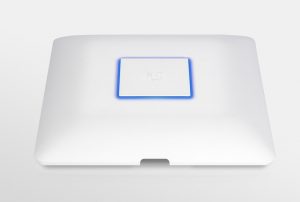 A few weeks ago, I purchased and installed a Ubiquiti UniFi AC access point in my home and its the best WiFi coverage that I have ever had. The UniFi AC is an 802.11ac access point that supports both 2.4Ghz and 5Ghz simultaneously. At the 5Ghz frequency, the device is rated for up to 1300Mbps throughput and 450Mbps throughput over 2.4Ghz. It supports client devices on 802.11a/b/g/n & ac. All of these standards are supported over the same SSID, meaning your device can prefer 5Ghz when close enough and 2.4Ghz when further away.
A few weeks ago, I purchased and installed a Ubiquiti UniFi AC access point in my home and its the best WiFi coverage that I have ever had. The UniFi AC is an 802.11ac access point that supports both 2.4Ghz and 5Ghz simultaneously. At the 5Ghz frequency, the device is rated for up to 1300Mbps throughput and 450Mbps throughput over 2.4Ghz. It supports client devices on 802.11a/b/g/n & ac. All of these standards are supported over the same SSID, meaning your device can prefer 5Ghz when close enough and 2.4Ghz when further away.
The AP has two Ethernet ports, with one being PoE to power the device. There is not a separate power connector, but the unit does come with a PoE injector that accepts the uplink and then provides power and uplink to the access point.
The UniFi AC is a dedicated access point only, so you will need a separate router. If you are like most customers, your DSL or cable modem comes with an integrated router. The WiFi on these carrier provided devices is often anemic, at best. So adding a more powerful access point can be a great solution for solid WiFi while leveraging your modem/router from your Internet service provider, that the ISP fully supports.
Installation
Installation and configuration is simple. Plug in the PoE injector into a power outlet, connect the network uplink network into the LAN port of the injector and connect to the PoE port into the access point. This allows you to easily hide or disguise the power injector in a different location and all you need is an Ethernet cable where you want to locate the AP. For larger deployments, Ubiquiti offers PoE switches and routers that remove the need for the power injector or use any PoE enabled switch to power the AP.
Configuration is all handled through a software called UniFi controller. There is no on-board interface for configuration, you install and launch the Java/Tomcat based UniFi controller on a computer and it allows you to configure one or more UniFi AP’s. You may upload a map or pull in a map from Google Maps and place our AP on the map to see coverage expected.
Features
The UniFi AC allows for a separate guest network, including a separate VLAN all together if your network can support this. For businesses, you can setup hotspots with integration into billing portals and voucher-based authentication. In addition, you can limit the bandwidth of guest users.
The UniFi is capable of performing wireless uplink from AP to AP to extend range.
A beta version of the UniFi software is introducing a zero handoff feature where users can move from AP to AP in larger environments seamlessly like it were all one large AP.
Once configured, all of these features are available and continue to operate without the UniFi controller online. This is a huge plus since most standalone or enterprise-grade access points require a software or hardware controller to function. The UniFi line does offer enough brains to operate, even if the configuration requires the controller software.
A full rundown of all the features is available on the Ubiquiti website.
Verdict
You don’t have to spend much time on my blog to realize that I love Apple products. Recently, my Apple AirPort Extreme began exhibiting some flaky issues. After talking with technical support at my ISP, my router was determined to be the problem. Apple tech support was great and replaced my router under warranty, but in the meantime, I decided to invest in an upgrade.
At almost $300, the UniFi AC is not a cheap upgrade. 802.11ac is a very new standard and it is the fastest possible WiFi you can invest in. If you don’t need the speed of the AC model or want something more budget friendly, Ubiquiti also makes an UniFi AP 802.11n at a much more affordable price and I initially tried one of these from a coworker. I was so impressed, I went ahead and purchased my own 802.11ac model.
